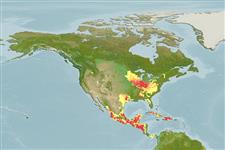Classification / Names
Common names | Synonyms | Catalog of Fishes (gen., sp.) | ITIS | CoL | WoRMS | Cloffa
Actinopterygii (ray-finned fishes) >
Characiformes (Characins) >
Characidae (Characins) > Incertae sedis
Etymology: Astyanax: The name of Astyanax, Hector´s son in the Greek mithology (Ref. 45335).
Environment / Climate / Range
Ecology
Freshwater; brackish; benthopelagic. Tropical; 20°C - 37°C (Ref. 36880), preferred ?
Central America: lower Rio Papaloapan and Colima, Mexico south to some places in Central America (Ref. 30499), extending to the Rio Cocle del Norte and Rio Tabasara in Panama (Ref. 36880).
Size / Weight / Age
Maturity: Lm ? range ? - ? cm
Max length : 7.5 cm SL male/unsexed; (Ref. 30499); 12.0 cm SL (female)
Differs from A. nasutus and A. orthodus by its distinct humeral blotch and intermediate body depth. Sides and belly silvery over pearl white merging to a greenish brown back; in preserved specimens, a gray band runs from the humeral mark to the caudal peduncle which has a jet black rhomboidal mark extending to the tip of the middle caudal rays; transparent fins with minimal dark pigment; usually first rays of anal and sometimes dorsal and caudal fins with red or yellow pigment (Ref. 36880).
Inhabits all types of rivers and streams, from swift water to swamps and stagnant pools (Ref. 36880). Tolerates brackish water at sea level to small mountain brooks at 1000 m elevation (Ref. 36880). Forms schools over any type of substrate (Ref. 36880). Feeds on algae, seeds, leaves, aquatic and terrestrial insects and fish fry of any species (Ref. 36880). Spawns during most of the year at some sites or seasonally in other places (Ref. 36880).
Life cycle and mating behavior
Maturity | Reproduction | Spawning | Eggs | Fecundity | Larvae
Bussing, W.A., 1998. Peces de las aguas continentales de Costa Rica [Freshwater fishes of Costa Rica]. 2nd Ed. San José Costa Rica: Editorial de la Universidad de Costa Rica. 468 p. (Ref. 36880)
IUCN Red List Status (Ref. 115185)
CITES (Ref. 94142)
Not Evaluated
Threat to humans
Harmless
Human uses
More information
Common namesSynonymsMetabolismPredatorsEcotoxicologyReproductionMaturitySpawningFecundityEggsEgg development
ReferencesAquacultureAquaculture profileStrainsGeneticsAllele frequenciesHeritabilityDiseasesProcessingMass conversion
Tools
Special reports
Download XML
Internet sources
